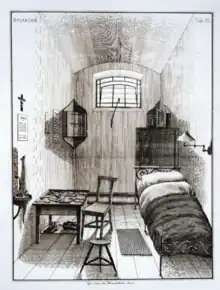Saint-Gilles Prison
Saint-Gilles Prison (French: Prison de Saint-Gilles, Dutch: Gevangenis van Sint-Gillis) is a prison in Brussels, Belgium, that opened in 1884.[1] It is located on the borders of the municipalities of Saint-Gilles, Ixelles and Forest, next to Forest Prison and Berkendael Prison.
 Front entrance to Saint-Gilles Prison | |
| Coordinates | 50°49′17″N 04°20′51″E |
|---|---|
| Status | Operational (scheduled to close) |
| Capacity | 750 |
| Opened | 1884 |
| Street address | Avenue Ducpétiaux / Ducpétiauxlaan 106/N 242 |
| City | Saint-Gilles, Brussels-Capital Region |
| Postal code | 1060 |
| Country | Belgium |
| Notable prisoners | |
| Edith Cavell, Louise de Bettignies, Gabrielle Petit, Alexander von Falkenhausen | |
Representative of the cellular system established during the 19th century,[2] Saint-Gilles Prison was for a long time emblematic of overcrowding in Belgian prisons. Its infrastructure being in very poor condition, it is scheduled to close at the end of 2024, when it will be replaced by Haren Prison.[3]
History
Inception and construction
During the period of the establishment of the Kingdom of Belgium in 1830, the country's prisons were made up a motley collection of buildings that were not destined to become places of confinement. This was particularly true of the many religious houses that had been confiscated as national property after the second French invasion of 1794 during the French Revolutionary Wars.[4] In 1830, Édouard Ducpétiaux was appointed inspector-general of prisons for the Provisional Government, only a few months after the Belgian Revolution, and was assigned the task of organising the national prison system in accordance with the most modern standards.[5] In 1848, the cellular system of imprisonment was adopted, when a decree established the principle of individual imprisonment into penal law.[5] This led to a programme of prison building in the country from 1850 onwards.[5]
Saint-Gilles Prison was first planned in 1883 to replace the Petits Carmes Prison located in central Brussels.[6][7] The prison was designed by the Belgian architect Joseph Jonas Dumont and built by the Belgian-French engineer and sculptor Francois-Jacques Derre between 1878 and 1884.[6] It is representative of the cellular system established during the 19th century.[2] Originally a remand and sentencing prison, it housed people (men and women separately) placed under arrest warrant as preventive detention,[8] as well as those sentenced to police or correctional sentences for the judicial arrondissement of Brussels. After it proved insufficient to fulfil this dual function, the new Forest Prison located next door took on the role of remand prison in 1909.[9]
Incarceration during World War I

During World War I, with the exception of the territory behind the Yser river, Belgium was under German occupation. The Germans incarcerated at Saint-Gilles Prison those awaiting trial before the German Council of War in Brussels.[10] Individuals who were "part of clandestine networks, others who had publicly protested against the abuses of the occupying forces, or those who had attempted to cross the Dutch border" were systematically sentenced to imprisonment.[10] Some were transferred to Germany to serve their sentences. Several testimonies report violent treatment in the Brussels prison environment during this period, including cases of physical brutality, death threats and other acts of intimidation.[10]
Among the most notable women incarcerated at the prison were the English nurse Edith Cavell,[11] the French secret agent Louise de Bettignies,[12] and the Belgian spy Gabrielle Petit.[13] Petit's prison cell was preserved for posterity.[14]
Incarceration during World War II

During World War II, a large number of opponents of the German Nazi regime were imprisoned at Saint-Gilles Prison, either at the disposal of the German police, or to serve a sentence, or prior to their deportation to Germany, most often to Buchenwald. An infirmary was set up in the prison during the war, allowing prisoners from Fort Breendonk to be treated there.[15]
After the war, the leaders of the collaborators and of certain political and military organisations, as well as propagandists and spies, were locked up at the prison.[16] Notably, General Alexander von Falkenhausen, military governor of Belgium and northern France during the occupation, was detained there from 1948 to 1951.
Later years and closure
In the 1980s, Jean Bultot, who was named in the Nijvel Gang case, was deputy director of Saint-Gilles Prison. In the decades that followed, many tensions arose at the prison, including due to overcrowding and staff shortages, leading to prisoner uprisings (such as in 1987 and 2009) and staff strikes.[17] Since the 1990s, the prison has been overcrowded, with about eight hundred inmates (mainly pre-trial detainees).[18][19] On 3 May 1993, the gangsters Murat, Lacroix and Bajrami escaped from the prison. They took then-inspector-general Harry Van Oers hostage, forced him onto the bonnet of their getaway car and drove out of the prison gate.[20]
As of 2023, Saint-Gilles Prison is scheduled to close. Three cell wings in the prison will remain in use until the end of 2024, when it will be replaced by Haren Prison.[3]
Location and accessibility

Saint-Gilles Prison is located at 106, avenue Ducpétiaux/Ducpétiauxlaan in Saint-Gilles, on the borders with Ixelles and Forest.[21] The rear of the surrounding wall borders the Avenue de la Jonction/Verbindingslaan, opposite Forest Prison. The two prisons are connected by an underground passage used to serve to transfer prisoners. This close proximity causes frequent confusion between the two prisons in the media.
The Brussels-Capital Region has, in total, three prisons in the area: Saint-Gilles Prison, Forest Prison, as well as its women's quarter (known as Berkendael Prison), whose separate entrance opens onto the Rue de Berkendael/Berkendaalstraat. This site is served by the premetro (underground tram) station Albert (on lines 3 and 4), as well as the bus stop Prison/Gevangenis (on line 54).[22]
References
Citations
- "Plus d'infos sur la prison de Saint-Gilles" [More information on Saint-Gilles prison]. Service public fédéral de justice (SPF Justice) (in French). Retrieved 3 September 2023.
- Feyaerts 2018, p. 17–31.
- "Haren (Brussel) Gevangenis(dorp) Federale Overheidsdienst Justitie" [The Haren (Brussels) Prison (village) Federal Public Service of Justice] (in Dutch). 4 October 2022.
- Stevens 1885, pp. 327–346.
- Vanhulle 2010, pp. 107–130.
- Picqué 2016, p. 150.
- "Prison de Saint-Gilles". Inventaire du patrimoine architectural (in French). Collection cartes postales Dexia Banque. CHDStG. Retrieved 3 September 2023.
- "Prisons belges". Service public fédéral de justice (SPF Justice) (in French). Retrieved 1 October 2023.
- "Prison de Forest – Inventaire du patrimoine architectural". monument.heritage.brussels (in French). Retrieved 1 October 2023.
- Debruyne, Reszöhazy & Van Ypersele 2018, p. 65–90.
- Hoehling 1957, p. 1320.
- "Louise de Bettignies 1880-1918". Chemins de Mémoire. Paris: Ministère des Armées. Retrieved 1 October 2023.
- "Gabrielle Petit 1893-1916". Chemins de Mémoire. Paris: Ministère des Armées. Retrieved 28 September 2023.
- Pickles 2016, p. 198.
- Maerten 2016.
- "Inventaire des archives de la prison de Saint-Gilles - Archives de l'État en Belgique". www.arch.be (in French). Retrieved 28 September 2023.
- Deceulaer, De Prins & Tallier 2019.
- "Rapport annuel de la direction générale Etablissements pénitentiaires (DG EPI)" (PDF). Service public fédéral de justice (SPF Justice) (in French). 2017. p. 44. Retrieved 1 October 2023.
- "Rapport au Gouvernement de la Belgique relatif à la visite effectuée en Belgique par le Comité européen pour la prévention de la torture et des peines ou traitements inhumains ou dégradants (CPT)". Conseil de l'Europe (in French). 8 March 2018. p. 5. Retrieved 1 October 2023.
- Van Oers 2010.
- "Prison de Saint-Gilles". Service public fédéral de justice (SPF Justice) (in French). Retrieved 28 September 2023.
- "Ligne 54 vers TRONE - stib.be". Stib Mvib. Retrieved 28 September 2023.
Bibliography
- Debruyne, Emmanuel; Reszöhazy, Elise; Van Ypersele, Laurence (2018). "Dans les mains de la police allemande. Les violences carcérales et policières comme expérience d'occupation en Belgique, 1914-1918" [In the hands of the German police. Police and prison violence as an experience of occupation in Belgium, 1914-1918.]. Guerres Mondiales et Conflits Contemporains. 272 (4): 65. doi:10.3917/gmcc.272.0065.
- Deceulaer, Harald; De Prins, Gert; Tallier, Pierre-Alain (2019). Inventaris van het archief van de gevangenis van Sint-Gillis, 1885-1991 (in Dutch). Algemeen Rijksarchief. ISBN 978-94-6391-021-7.
- Feyaerts, Jozefien (2018). "Building services in nineteenth-century Belgian cellular prison architecture". In Campbell, James W.P.; Baker, Nina; Boyington, Amy; Driver, Michael; Heaton, Michael; Pan, Yiting; Schoenefeldt, Henrik; Tutton, Michael; Yeomans, David (eds.). Studies in the History of Services and Construction The proceedings of the Fifth Conference of the Construction History Society. Cambridge: University of Cambridge. ISBN 978-0-9928751-4-5.
- Hoehling, A. A. (1957). "The Story of Edith Cavell". The American Journal of Nursing. 57 (10): 1320–1322. doi:10.2307/3461516. JSTOR 3461516.
- Maerten, Fabrice (16 March 2016). "Parcours de résistant. De l'arrestation à la déportation" (PDF). Démocratie ou barbarie (in French). Retrieved 28 September 2023.
- Picqué, Charles (2016). Saint-Gilles : Huit siècles d'histoires 1216-2016 (in French). Mardaga. ISBN 978-2-8047-0343-1.
- Pickles, K. (2016). Transnational Outrage: The Death and Commemoration of Edith Cavell. Basingstoke, New York: Springer. ISBN 978-0-230-28608-5.
- Stevens, J (19 September 1885). "Rapport". Actes du Congrès pénitentiaire international de Rome, novembre (in French). Vol. 3, Part 1. Saint Gilles, Brussels.
{{cite book}}: CS1 maint: location missing publisher (link) - Vanhulle, Bert (2010). "Dreaming about the prison: Édouard Ducpétiaux and Prison Reform in Belgium (1830- 1848)". Crime, Histoire & Sociétés / Crime, History & Societies. Librairie Droz. 14 (2): 107–130. JSTOR 42708789.
- Van Oers, Harry (2010). De dag van de grote ontsnapping (in Dutch). Antwerp: Witsand. ISBN 9789490382377.